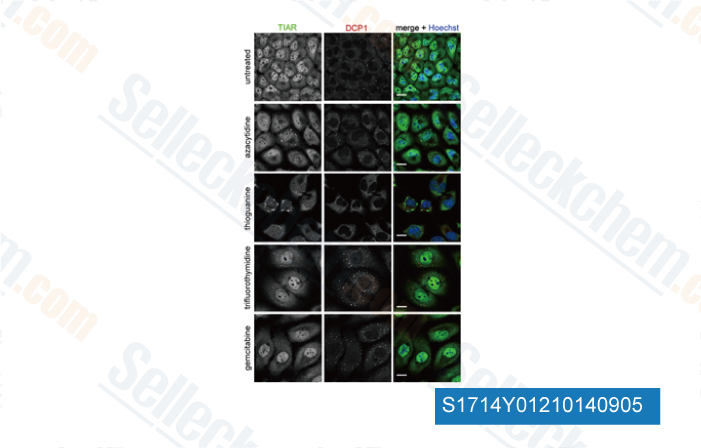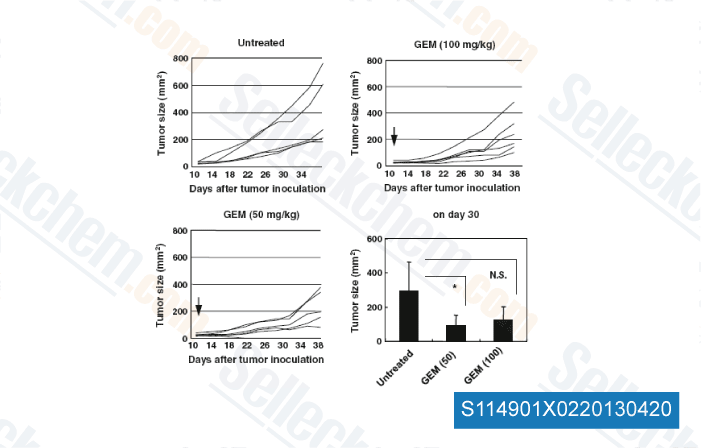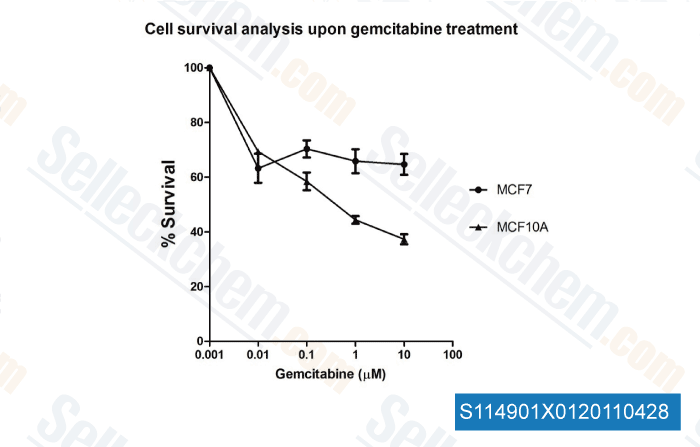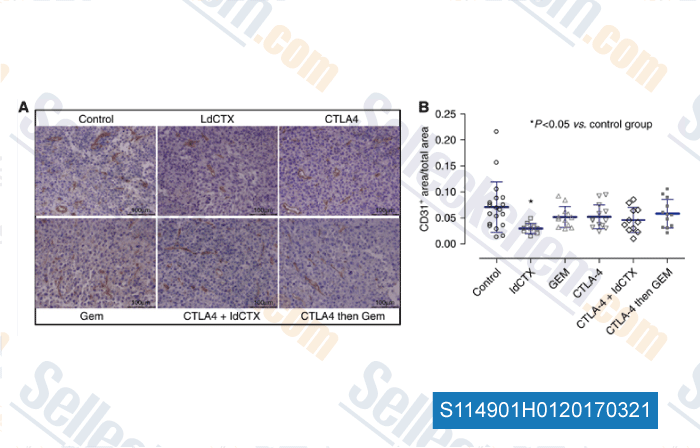|
Toll Free: (877) 796-6397 -- USA and Canada only -- |
Fax: +1-832-582-8590 Orders: +1-832-582-8158 |
Tech Support: +1-832-582-8158 Ext:3 Please provide your Order Number in the email. |
Technical Data
| Formula | C9H11F2N3O4.HCI |
|||
| Molecular Weight | 299.66 | CAS No. | 122111-03-9 | |
| Solubility (25°C)* | In vitro | Water | 59 mg/mL (196.88 mM) | |
| DMSO | Insoluble | |||
| Ethanol | Insoluble | |||
|
* <1 mg/ml means slightly soluble or insoluble. * Please note that Selleck tests the solubility of all compounds in-house, and the actual solubility may differ slightly from published values. This is normal and is due to slight batch-to-batch variations. * Room temperature shipping (Stability testing shows this product can be shipped without any cooling measures.) |
||||
Preparing Stock Solutions
Biological Activity
| Description | Gemcitabine is a pyrimidine nucleoside analog antitumor drug that can inhibit DNA synthesis and repair, leading to cell autophagy and apoptosis. It is mainly used to treat various solid tumors such as pancreatic cancer and non-small cell lung cancer, and is often combined with chemotherapy to enhance efficacy. | ||||||||
|---|---|---|---|---|---|---|---|---|---|
| Targets |
|
||||||||
| In vitro | Gemcitabine induced NF-κB activity in BxPC-3, PANC-1, and MIA PaCa-2 cells and decreased the level of the NF-κB inhibitor IκBα in BxPC-3 and PANC-1 cells. Treatment of BxPC-3 cells with low dose Gemcitabine for 48 hours results in a dose-dependent increase in NF-κB binding. In contrast, NF-κB DNA binding is decreased in BxPC-3 cells treated with the higher Gemcitabine doses for 48 h; however, 24-h treatment with these higher doses increases NF-κB binding in BxPC-3 cells [2] | ||||||||
| In vivo | Intratumoral NF-κB activity is significantly elevated (1.3- to 1.8-fold) in the Gemcitabine-treated mice compared to the PBS-treated mice, suggesting that Gemcitabine also induces NF-κB activation. [2] | ||||||||
| Features | Gemcitabine has been used to treat pancreatic cancer and has demonstrated effective anti-tumor activity. |
Protocol (from reference)
| Cell Assay:[2] |
|
|---|---|
| Animal Study:[2] |
|
References
|
Customer Product Validation

-
Data from [ Nucleic Acids Res , 2014 , 42(10), 6436-47 ]

-
Data from [ Cancer Immunol Immunother , 2013 , 62, 383–391 ]

-
, , Dr. Helen Sadik of Johns Hopkins University

-
Data from [ , , Br J Cancer, 2017, 116(3):324-334 ]
Selleck's Gemcitabine HCl Has Been Cited by 191 Publications
| Macropinocytosis maintains CAF subtype identity under metabolic stress in pancreatic cancer [ Cancer Cell, 2025, S1535-6108(25)00271-5] | PubMed: 40712568 |
| Dynamic regulation of integrin β1 phosphorylation supports invasion of breast cancer cells [ Nat Cell Biol, 2025, 27(6):1021-1034] | PubMed: 40419795 |
| Senescence-associated lysosomal dysfunction impairs cystine deprivation-induced lipid peroxidation and ferroptosis [ Nat Commun, 2025, 16(1):6617] | PubMed: 40731111 |
| Pancreatic cancer-derived extracellular vesicles remodel the tumor microenvironment and enhance chemoresistance by delivering KRASG12D protein to cancer-associated fibroblasts [ Mol Ther, 2025, S1525-0016(25)00027-9] | PubMed: 39810420 |
| NIR pH-Responsive PEGylated PLGA Nanoparticles as Effective Phototoxic Agents in Resistant PDAC Cells [ Polymers (Basel), 2025, 17(8)1101] | PubMed: 40284366 |
| UPP1 enhances bladder cancer progression and gemcitabine resistance through AKT [ Int J Biol Sci, 2024, 20(4):1389-1409] | PubMed: 38385072 |
| A novel DDIT3 activator dehydroevodiamine effectively inhibits tumor growth and tumor cell stemness in pancreatic cancer [ Phytomedicine, 2024, 155377] | PubMed: none |
| CCL3 predicts exceptional response to TGFβ inhibition in basal-like pancreatic cancer enriched in LIF-producing macrophages [ NPJ Precis Oncol, 2024, 8(1):246] | PubMed: 39478186 |
| Establishment, characterization, and biobanking of 36 pancreatic cancer organoids: prediction of metastasis in resectable pancreatic cancer [ Cell Oncol (Dordr), 2024, 10.1007/s13402-024-00939-5] | PubMed: 38619751 |
| Obg-like ATPase 1 exacerbated gemcitabine drug resistance of pancreatic cancer [ iScience, 2024, 27(6):110027] | PubMed: 38883822 |
RETURN POLICY
Selleck Chemical’s Unconditional Return Policy ensures a smooth online shopping experience for our customers. If you are in any way unsatisfied with your purchase, you may return any item(s) within 7 days of receiving it. In the event of product quality issues, either protocol related or product related problems, you may return any item(s) within 365 days from the original purchase date. Please follow the instructions below when returning products.
SHIPPING AND STORAGE
Selleck products are transported at room temperature. If you receive the product at room temperature, please rest assured, the Selleck Quality Inspection Department has conducted experiments to verify that the normal temperature placement of one month will not affect the biological activity of powder products. After collecting, please store the product according to the requirements described in the datasheet. Most Selleck products are stable under the recommended conditions.
NOT FOR HUMAN, VETERINARY DIAGNOSTIC OR THERAPEUTIC USE.
